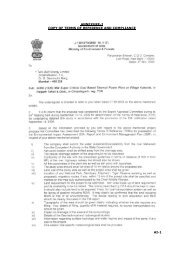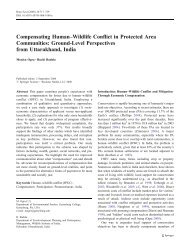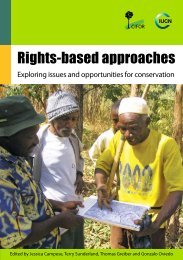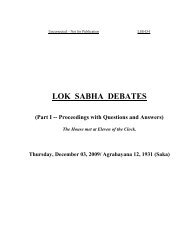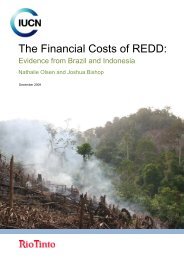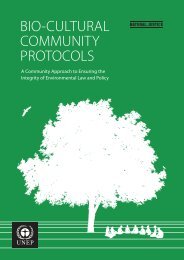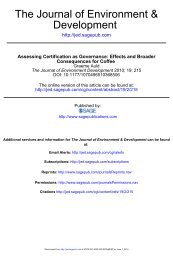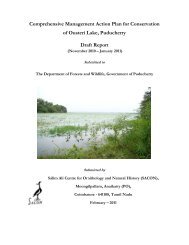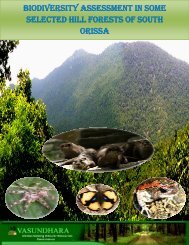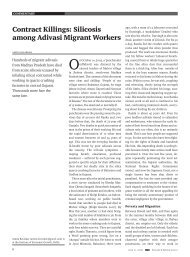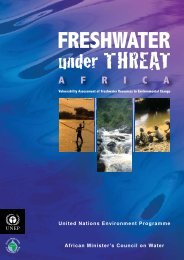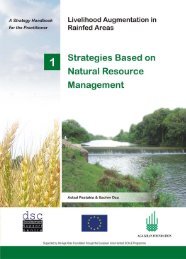Integrated River Basin Planning – Replicable ... - India Water Portal
Integrated River Basin Planning – Replicable ... - India Water Portal
Integrated River Basin Planning – Replicable ... - India Water Portal
Create successful ePaper yourself
Turn your PDF publications into a flip-book with our unique Google optimized e-Paper software.
<strong>Integrated</strong> <strong>River</strong> <strong>Basin</strong> <strong>Planning</strong>: <strong>India</strong> and the EU share experience on policy and practice<br />
<strong>Water</strong> and Environmental Policies in <strong>India</strong><br />
chairman appointed by the GoI and has members from governments of the basin<br />
states. The main functions include<br />
(i)<br />
(ii)<br />
(iii)<br />
preparation of plans for flood control and utilisation of water resources for<br />
various uses;<br />
preparation of detailed designs and cost estimates for proposed projects;<br />
and<br />
construction, maintenance and operations of multipurpose projects with<br />
the approval of the Government of <strong>India</strong>.<br />
Bhakra-Beas Management Board: The Bhakra-Beas Management Board<br />
(BBMB) was constituted through an executive order in accordance with Section<br />
79 of the Punjab Reorganisation Act 1966 to regulate the supply of the Sutlej, Ravi<br />
and Beas <strong>River</strong>s to the states of Punjab, Haryana, Rajasthan and the National<br />
Capital Territory of Delhi. The Board is headed by a chairman appointed by<br />
the GoI and has members from basin states. The BBMB is responsible for the<br />
operation and maintenance of the projects under its jurisdiction and to allocate<br />
water for irrigation based on inflows to reservoirs. In addition, it distributes power<br />
in consultation with beneficiary states. The BBMB, like the DVC, functions under<br />
the control of the Union Power Ministry, and not the <strong>Water</strong> Resources Ministry.<br />
Upper Yamuna <strong>River</strong> Board: The Upper Yamuna <strong>River</strong> Board (UYRB) was<br />
constituted for the<br />
(i)<br />
(ii)<br />
(iii)<br />
(iv)<br />
regulation and supply of water from all storages and barrages up to and<br />
including Okhla Barrage;<br />
maintenance of minimum flows;<br />
monitoring of return flow quantities from Delhi after allowing for consumptive<br />
use; and<br />
coordination for the maintenance of water quality, conservation, etc.<br />
Narmada Control Authority is in charge of overseeing the implementation of<br />
the award of the Narmada <strong>Water</strong> Dispute Tribunal for planning and management<br />
and sharing of benefits from the Sardar Sarovar Project (World Bank, 1998,<br />
Union Ministry of <strong>Water</strong> Resources website, 1999). What is clear from the origin,<br />
functions and constitution of these RBOs is that they are all structured for planning,<br />
design and implementation of large projects. It is also clear that they do not even<br />
intend to be participation-oriented or open bodies. Proper river basin organisation<br />
encompassing the needs, resources and priorities of whole river basin or even for<br />
most of a river basin has not been done in the case of a single river basin in <strong>India</strong>.<br />
The origin, functions and constitution of RBOs in <strong>India</strong> show that they are all<br />
structured for planning, design and implementation of large projects and remain<br />
techno-centric. They do not yet factor in the need to be community participationoriented.<br />
The emergence of various community-based initiatives has been witnessed<br />
despite the above-described limitation. The approach of RBO management must<br />
become process-oriented and context-specific. The RBOs involved in managing<br />
the river systems should provide an ‘enabling environment’ for understanding the<br />
dynamic and complex river system through an ‘interactive approach’ to scaling<br />
up and participatory management. This requires the government institutions to<br />
restructure with a view to devolve powers to community institutions for evolving<br />
options for river basin development.<br />
The institutional structure for river basin management is relevant as water resources<br />
development in <strong>India</strong> has been centred on large dams. However, the RBOs in<br />
<strong>India</strong> do not truly reflect the characteristics of integrated river basin management.<br />
By and large, they have attempted to address issues in isolation, and have been<br />
centred mainly on pollution abatement (e.g. earlier Ganga Action Plan, Yamuna<br />
Action Plan and more recently the Pamba Action Plan of the State Pollution<br />
Control Board). The techno-centric approaches have been largely guided with an<br />
engineering perspective and have several operational and institutional drawbacks.<br />
The Board is headed by the Member, <strong>Water</strong> <strong>Planning</strong> and Projects of the CWC<br />
and has members from the basin states.<br />
Ganga Flood Control Board (GFCB) and Ganga Flood Control Commission<br />
(GFCC): The Ganga Flood Control Board was set up in 1972 by a GoI Resolution.<br />
The Ganga Flood Control Commission was set up as per Clause 5 of the<br />
Resolution to undertake specific works in the Ganga <strong>Basin</strong> and for assisting the<br />
Ganga Flood Control Board. The GFCC is expected to prepare a master plan of<br />
the basin to deal with problems emerging from flood erosion and waterlogging<br />
in the region. The implementation of these will be carried out by the appropriate<br />
riparian state. A chairman appointed by the GoI heads the Commission. The GoI<br />
also appoints two full time members. <strong>Basin</strong> states appoint part-time members to<br />
the Commission.<br />
Other organisations: Betwa <strong>River</strong> Board was constituted under the Betwa <strong>River</strong><br />
Board Act (1976) for efficient, economical and early execution of the Rajghat<br />
Dam Project. The Bansagar Control Board was constituted in January 1976 for<br />
efficient, economical and early execution of Bansagar Dam and connected works<br />
across the Sone <strong>River</strong>. Mahi Control Board was constituted for Mahi Bajajsagar<br />
Project across Mahi <strong>River</strong>.<br />
20 21



